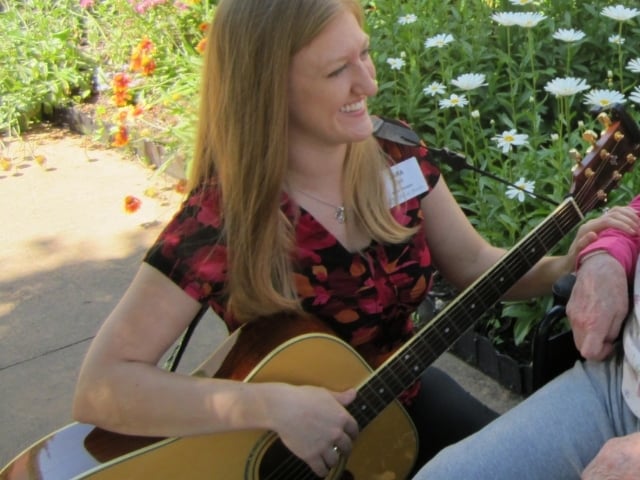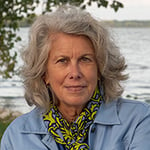Published: December 8, 2023

Whether you’re listening to music or making it, the eclectic art has lots to offer, young and old. Music can comfort, energize, heal, inspire, and refresh, just to name a few benefits.
For many of us the benefits are casual and informal, but other times the benefits are intentional and structured, as in music therapy. Let’s explore both, which by the way, resonate throughout the Kendal community.
Music therapy 101
Here’s the definition from the America Music Therapy Association:
Music therapy is the clinical & evidence-based use of music interventions to accomplish individualized goals within a therapeutic relationship by a credentialed professional who has completed an approved music therapy program. Music therapy interventions can address a variety of healthcare & educational goals:
- Promote Wellness
- Manage Stress
- Alleviate Pain
- Express Feelings
- Enhance Memory
- Improve Communication
- Promote Physical Rehabilitation
According to the Cleveland Clinic, specific illnesses, health concerns and conditions that can benefit from music therapy include dementia, traumatic brain injuries, cancer, mood and anxiety disorders and childhood behavior and learning issues.
Music therapy occurs in many settings, from hospitals and schools to drug treatment centers and in life plan communities.
Music in the (Kendal) air
Certified Music Therapist Jara Dell has been working at Kendal for 18 years, primarily with residents of the Stephens Care Center.
“I’m really looking at quality of life. I want to see smiles and hear their stories. I want to see how music can make someone’s day better,” Jara says.
Current activities at Kendal include:
- Morning Music, where four times a week residents gather to sing familiar songs, such as oldies, hymns and patriotic tunes. Jara plays several instruments but mostly piano for the singalongs;
- Singing Buddies, a weekly gathering that follows a therapeutic program designed for people with cognitive issues called SingFit, which uses curated playlists (travel, food, etc.) to generate memories and discussions;
- Bell Choir, which uses bells as a fun way for residents to make music.
During the annual winter solstice celebration, the Bell Choir typically performs a piece, either live or pre-recorded. Jara moves around the semi-circle, pointing to residents when it’s their turn to play. “That way residents don’t have to be able to read music,” Jara says, adding “We focus on what residents can do, not what they can’t do.”
Kendal is home to many musicians and musical lovers. With five pianos located in public spaces, many scheduled concerts and frequent spontaneous informal gatherings, music is very much a part of Kendal’s DNA.
Residents are avid concert-goers too, and often fill the auditorium at Oberlin College concerts. “So many residents say one of the main reasons they moved to Kendal is because of the Conservatory,” says Dianne Haley, who plays the piano.
No surprise that the December calendar is packed with musical gatherings, from singalongs to marimba performances (from both Jara and Oberlin College).
Speaking of holiday music…
Yes, sometimes the constant buzz of listening to holiday music can get annoying, but singing, well that’s a different story, according to Ronald Borczon, professor of music therapy at Biola University in Southern California.
One of the great positive effects is when people are together singing the Christmas music. There’s great research on how singing in choirs or singing in groups really helps bond the group as well as helps you feel better, so this is one way of singing in groups that really promotes a sense of togetherness, a sense of purpose, as well as the physical action of singing. When you have to sing, your brain goes into all these different areas to create sound, to create melody. If you see an MRI of the brain when someone’s playing music, it’s just lighting up everywhere. Some say it’s lighting up like a Christmas tree when you’re playing or singing music. So all those things are happening in the moment when you’re singing in a group. So it’s really a good thing.
Learn More About Kendal at Oberlin – A Vibrant Community for Older Adults
Are you making plans for your future? Kendal at Oberlin offers an active lifestyle with opportunities for lifelong learning, art and culture.
 In the past, Molly Kavanaugh frequently wrote about Kendal at Oberlin for the Cleveland Plain Dealer, where she was a reporter for 16 years. Now we are happy to have her writing for the Kendal at Oberlin Community.
In the past, Molly Kavanaugh frequently wrote about Kendal at Oberlin for the Cleveland Plain Dealer, where she was a reporter for 16 years. Now we are happy to have her writing for the Kendal at Oberlin Community.
About Kendal at Oberlin: Kendal is a nonprofit life plan community serving older adults in northeast Ohio. Located about one mile from Oberlin College and Conservatory, and about a 40 minute drive from downtown Cleveland, Kendal offers a vibrant resident-led lifestyle with access to music, art and lifelong learning.




